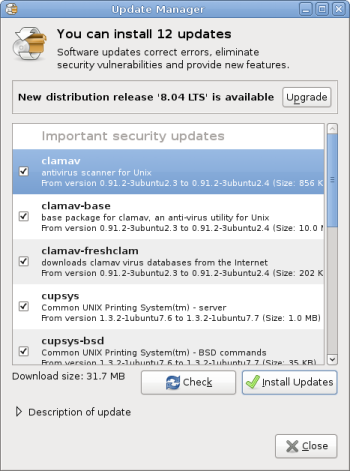Author: Joe Barr
Which path should you follow? Should you take advantage of Ubuntu’s package manager and use it to upgrade your system to the latest 8.04 Hardy Heron release, or should you download a CD or DVD ISO image and do a clean install? Common wisdom says that doing a clean install is the better, safer course of action. There may be a little extra work involved configuring everything once the latest and greatest is installed, but that’s nothing compared to the pain of an update gone wrong, according to traditional thinking. But that cautious approach may no longer be necessary.
I did a clean install of Ubuntu 8.04 recently on my development machine. It was a quick and easy process. I backed up the data and configuration files residing in my /home directory, installed the new release, then copied my saved data back in place. Nothing to it, and everything worked when I was through.
But when the Ubuntu 7.10 package manager recently offered to upgrade me to release 8.04 when it was showing me the latest security updates available, I decided it was time to try the upgrade path as well.
I did this in spite of the advice I heard in the #ubuntu channel at irc.freenode.net. The unanimous opinion I received from the three people who responded was to do a clean install, although one of the three said he personally used upgrade because it left him with less to do afterward. The reasons for recommending a clean install included risk avoidance, better results for complex configurations, and speed. One of the three noted most of the 8.04 installation problems he had seen in the channel came from those taking the upgrade path.
Back up early and often
When you do a clean install, you know beforehand that you are going to lose everything you don’t specifically back up and then restore after the install. When you do an update, you hope that everything will still be there and still work when you’re finished. The most important thing to remember when doing an update is the same thing that’s most important to remember when you do a clean install: back up everything before you begin.
I have two hard drives on my primary desktop. One is almost completely dedicated to backing up my email, photo, video, and text files from my /home directory. It has gotten quite large over the years. Before starting the upgrade process to Ubuntu 8.04, I made sure my backups were completely up-to-date.
I started the upgrade at 11:00 a.m. one morning, and finally finished the process at 6:30 a.m. the next day. Yes, I did take time off to sleep, but that’s still a long time. In comparison, doing a clean install took only an hour on my alternate desktop machine.
The process begins by downloading the upgrade tool. That’s followed by something called “setting new software channels,” which appears to be identifying which repositories you need in order to bring all currently installed applications up-to-date. Those two tasks combined took less than half an hour to finish.
The largest chunk of time — about 12 hours — was spent downloading new packages. I’m sure much of the reason for the slow speed can be attributed to the fact that many others were doing the same thing at the same time I was, with available bandwidth shrinking to fit demand. Downloading and burning a complete 8.04 ISO image took less than an hour a few days earlier. Because it took so long to download the new packages, I ran another backup of my email files when I was ready to start applying changes, then closed the email app — just in case.
The next step was to install and configure the new packages. This, too, takes longer to do than starting from scratch with a new install — about an hour on my machine. Early on, the progress bar advised I had 33 minutes remaining, but the remaining time shown increased the further it went. In the end, I went to bed and let it continue by itself. A couple of the applications (CUPS and PostgreSQL) required interactive participation, so when I returned to the computer the next morning, I had to choose between keeping the old configuration files or replacing them.
The remaining upgrade steps (cleanup and reboot) went smoothly, and I finally found myself sitting across the keyboard from Ubuntu 8.04, almost 24 hours after my journey began. But my email accounts and data were there immediately, and my browser toolbar and bookmarks were present and accounted for as well.
Which is best?
Having installed Ubuntu 8.04 both ways, by upgrade and also with a fresh installation, which do I prefer and which would I recommend? The answers are not the same.
After having used both, I’m solidly in the “clean install” corner. It was faster by far, and not only seems to be a cleaner course of action, with fewer opportunities for a misstep, but offers greater control over how the new installation will operate, since any and all control decisions bubble up to the surface during the process.
But the clean install approach may not be the right choice for you. In my mind, the swing point in the decision is this: if you are an experienced Ubuntu user more interested in having a system ready to use and as identical to the previous installation as possible, consider an upgrade instead of an install. If you are not as confident in your Ubuntu-foo, or are more interested in having the latest and greatest packages rather than a system that behaves immediately just as the previous one did, go with a clean install.
The good news is that both processes seemed to work well for me.
Categories:
- Ubuntu
- System Administration



